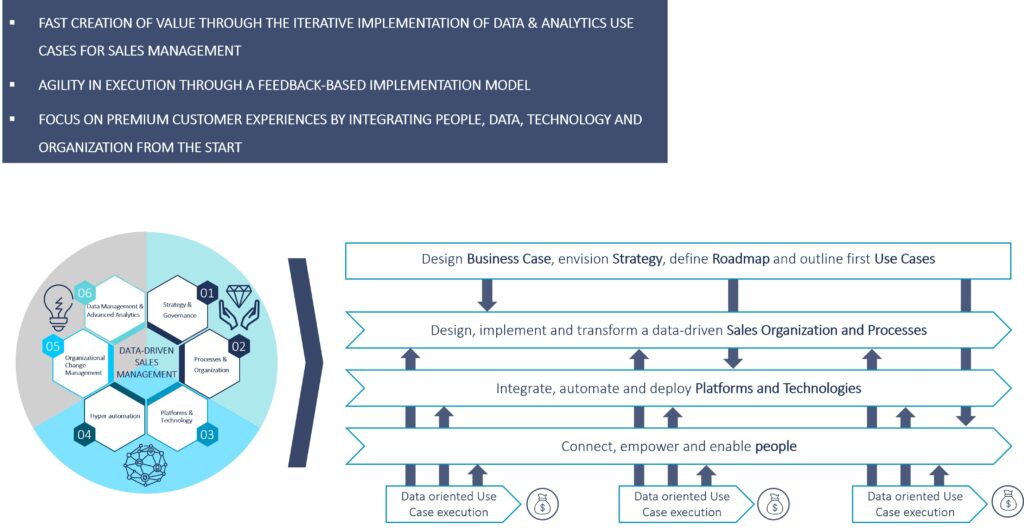
The Power of Automation in Data Migration
Automation is a practical solution to speed up and optimize the entire data migration process

“Big Data” and data-driven decisions have evolved well beyond being just a hype – they are becoming a reality within organizations. The trend towards data offers possibilities for companies that seem almost limitless. However: “With great power comes great responsibility”. In this case, this means to not just think big, but to use data in a smart way – especially when it comes to using data. Only then can a transformation to a data-driven sales model be successful.
In the automotive industry in particular, there are factors that set this sector apart from other industries and that need to be considered for any initiative towards a data-driven sales model. In fact, the automotive industry is mainly characterized by high-cost products as well as demanding customers, set in a sales landscape defined by a constantly growing complexity. On top of that, OEMs usually have a myriad of data and data sources, adding their own complexity to the mix.
In order to survive in this dynamic environment, it needs a new way of thinking: an approach that relies on data and not just intuition. With this in mind, the Camelot Data-Driven Sales Management approach for the automotive industry aims to generate added value for sales in the automotive sector from diverse mountains of data.
In most cases, the transformation to a data-driven sales model is not as simple as the inflationary use of terms such as “AI-based”, “data-driven” and “big data” over the past years might suggest. For initiatives to have a chance at success, awareness about challenges prior to any changes is vital. Also, it is important to be aware of the foundation needed to actually make data usable. Most automotive companies face comparable challenges that have their roots in the industry itself.
First, there is a multitude of sales channels with high complexity. They range from sales via car dealerships to direct sales from the manufacturer to the local newspaper’s classified ad section. This complexity is further increased by a mix of digital and traditional channels. On top comes the variety in models as a new car is rarely bought off the production line in a standard configuration but usually configured down to the smallest detail. This leads to a situation when offers need to be analyzed, often by using a comparison portal if one searches for a used car to buy. And there is an opportunity here: these channels can be planned and managed more efficiently, particularly through data-driven approaches. This makes it possible to address customers individually and effectively.
This leads us to another challenge: the challenging purchasing behavior in the automotive industry. Every customer has individual needs, and most individuals are becoming increasingly demanding as well as critical even with regards to details. Cars are a luxury item as they represent a significant investment. In addition, customers can draw on many sources of information these days, with a variety of (data) sources at their disposal. With that in mind, it becomes clear that buying a car is not a purely rational decision but associated with emotions. Customers therefore expect personalized experiences and products that are precisely tailored to their needs. Particularly with premium-class cars, most customers prefer to invest more time in the configuration process. In order to meet these demands as a manufacturer, a data-driven approach enables an optimized customer approach to precisely meet expectations and guide the customer through their buyer journey towards their dream car. Products are placed in a more targeted manner, thus increasing customer satisfaction.
On a data level, a heterogeneous system landscape with corresponding legacy data makes it difficult to merge and analyze existing data and derive sales forecasts. Typically, data is stored decentralized in custom-built (and often outdated) systems, with low data quality and without any data governance. Often, these systems are no longer supported, posing a security risk. Customer data and customer-specific characteristics are often maintained locally in Excel. In addition, media disruptions and different file formats make it difficult to cleanse and evaluate the existing data volumes, which is a crucial step before working with the data.
The Camelot Data-Driven Sales Management Framework tackles the challenges in the automotive industry. In particular, the modularity of the framework allows customer needs to be specifically addressed, thus supporting an adaptation towards individual objectives. The framework contains focus modules, which can be implemented in a holistic approach:
Strategy & Governance: Where are we coming from and where do we want to go? This module aims to design a clear business case with a target image as a guiding star for data-driven sales management. Combined with a precise assessment of the current situation, this module establishes the foundation for further steps and highlights specific areas where action is needed on the way to improving data usage.
Processes & Organization: Data should be used, in terms of availability, accessibility or quality, to name just a few dimensions. To achieve this, it is essential to align the organization and its processes with this. Optimizing the entire sales process with actual data ensures that the organization remains agile and efficient while learning to make better use of the available data.
Data Management & Technology: In this module, we look at the current systems and possible integration of the latest technologies and analytics tools to ensure that decisions have a solid data basis. We also look at the topic of data quality. Only high-quality data can be used for reliable decision-making.

The basis for a data-driven organization is built by competencies like data governance to ensure clear responsibilities and standards, data literacy to establish confidence in using data throughout the organization, and data architecture for the identification and description of data models and relationships. Overall, a well-designed, holistic data management eliminates silos, promotes informed decision-making, and enables efficient data processing. This is crucial when building a data-driven organization and data-driven business models, with data as a powerful tool for business success.
The Camelot Data-Driven Sales Management Framework supports our customers’ sales management to achieve the following goals:
Promote customer loyalty: “Get to know” the digital customer. This allows you to carry out targeted sales and marketing campaigns that fully meet customer needs.
Attract new customers: Better identify and understand individual needs. This enables a tailored approach to new customers by analyzing customer data and market trends.
Smart omnichannel selling: Optimal customer targeting on the most profitable sales channels. This is enabled by strategic, data-driven decision-making based on reliable data. Customers only see what is relevant to them, which makes them more inclined to act.
Increase profitability: Optimize efficiency in the sales organization. Sales channels can be evaluated through an integrative sales performance analysis and adjusted in case of doubt. As in a gearbox, tightening individual loose screws can bring an enormous advantage.
End-to-end value chain management: The fundamental aim of a data-driven organization is to identify bottlenecks, optimize processes and reduce costs along the entire value chain through cross-platform and seamless data integration and analysis.
The utilization of data is far from optional, especially in sales management. With the more complex sales landscape and the more demanding customers, companies from the automotive industry are forced to act if they want to remain competitive. Luckily, these developments also offer opportunities. Now is the time for the automotive industry to seize them and put data-driven sales management, and therefore the customer, at the heart of its strategy.

Automation is a practical solution to speed up and optimize the entire data migration process

Discover how you can streamline your financial master data management and reengineer financial processes with SAP MDG Finance.

Whilst it seems straightforward to carry out either a blood transfusion or a data migration, the actuality proves far more complex.

In this blog article, Camelot introduces you to the main principals of Demand-Driven Supply Chain Management.